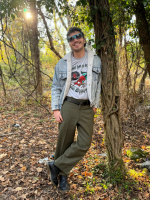Last year, researchers at the genetic testing company 23andMe and historians teamed up to parse through the DNA of about 30 bodies of enslaved people exhumed in Frederick, Maryland.
The bodies were found in 1979 after a previously unknown cemetery was found while the state worked on a highway.
The enslaved people worked and lived at Catoctin Furnace, an ironworking site that made materials like utensils and ammunition from the late 18th century to the early 20th century. All of them were unknown and there were no markers indicating anything about their lives.
The Catoctin Furnace Historical Society, along with Harvard University and 23andMe, has since been trying to find out who those people were through documentation and a vast genetic database.
The researchers found that there were at least 42,000 living relatives of those enslaved people. And now, they have traced and identified close genetic matches to a young, enslaved girl who was buried in the cemetery.
Anges Jackson, 86, is possibly the girl’s closest living relative and resides just half an hour drive from the site.
“Agnes shares almost double the amount of DNA than we detected with anybody else who was included in our original study,” said Eadaoin Harney, a population geneticist at 23andMe.
Jackson and her family are living, breathing relics of the girl who was forgotten in the cemetery a century and a half ago.
“I'm so thankful and I honestly believe that it's fate, and our faith that God has brought us to this point,” said Vicki Winston, Jackson’s daughter. “I just am so thankful that we found out about this little girl that at least we can go visit where she used to be. She was alone when she passed. Did she have any more relatives that were closer there? This is just overwhelming.”
The partnership between 23 and Me and Catoctin Furnace could change the landscape for understanding the heritage of many Black Americans who descend from enslaved people.
Prior to the 1870 census, records of enslaved people were sparse and described them as property rather than humans.
“It really is a brick wall of family research and genealogy in the African American community,” said Elizabeth Comer, the archaeologist at the Catoctin Furnace Historical Society. “That brick wall is really incredibly difficult to get over. Last names are, you know, not used, often, in inventories, people are characterized as, you know, 20 enslaved, but no names.
DNA projects like those at the Catoctin Furnace are giving voice and new life to the blood that continues to pump in Americans from their unknown ancestors.
“I think that this is really showing how genetics can help us shed light in this black box of the history that that the family history that that many African Americans have,” Harney said. What this means is that we can actually use DNA to kind of get beyond that brick wall, get into that black box, and find connections that really can't be discovered using documentation alone.”
23andMe is now offering a new feature that will link people to historical groups like the Catoctin ironworkers.




